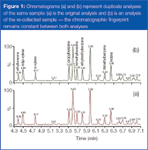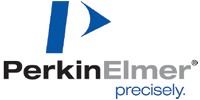Improving Sample Introduction in Arson Investigation Through Sample Re-Collection in Automated Thermal Desorption
LCGC Asia Pacific
The process of investigating a suspicious fire includes many different types of analyses. An essential step in confirming the presence of a liquid accelerant is gas chromatography (GC); detection with a mass spectrometer (MS) provides an accurate confirmation of both the presence and identity of an accelerant. In arson analysis, the sample preparation for GC–MS analysis is typically performed by headspace or solvent extraction.
The process of investigating a suspicious fire includes many different types of analyses. An essential step in confirming the presence of a liquid accelerant is gas chromatography (GC); detection with a mass spectrometer (MS) provides an accurate confirmation of both the presence and identity of an accelerant. In arson analysis, the sample preparation for GC–MS analysis is typically performed by headspace or solvent extraction.

Figure 1
The headspace sampling is followed by automated thermal desorption (ATD) sample introduction. ATD is known as a very sensitive and clean method, with the drawback that historically it was a "one shot" technique;1 once the sample is consumed, it is unavailable for re-analysis.
The novel thermal desorption technology used here includes sample re-collection, allowing laboratories to re-collect a portion of the sample so that it is available for additional analyses and archival, removing the "single shot" nature of ATD sample introduction. The following study will demonstrate sample re-collection and its effectiveness in arson investigation.
Experimental
A test sample of wood was burned with gasoline as an accelerant. The sample was collected in a 0.5 L glass jar; the accelerants were extracted from the jar by purging the headspace with clean, dry air, at 50 mL/min, while heating to 80 °C for 2 min. The air samples were collected onto an ATD sample tube packed with Tenax TA adsorbent, at room temperature. A PerkinElmer TurboMatrix 650 ATD introduced the air sample into the GC–MS system. The GC–MS system used in this study was the PerkinElmer Clarus 600 T GC–MS.
Discussion
Automated thermal desorption takes place in two steps — the primary and the secondary desorption. During each step the sample flow can be split; sample re-collection is activated only during the secondary desorption. The split effluent is directed to a sample tube, either the original tube or a new tube, rather than to vent. The number of cycles of sample re-collection is not limited; in methods using a high secondary split flow, duplicate data with high precision has been collected for more than 20 analyses of the same sample.
These results demonstrate that re-collection provides data consistent with the initial analysis. Beyond duplicate analysis, a re-collected sample can be stored for archival, in instances where a second analysis is required at a later date or analysed with a different split flow, achieving increased sensitivity or reduced sample size.
Conclusion
As with all forensic analyses, the data generated in arson investigation must be legally defensible; this creates the need for duplicate sample analysis as well as sample archival. The ability to re-collect a portion of a sample allows laboratories to perform multiple analyses of the same sample, as well as preserve a portion of the sample for archival. Thermal extraction combined with dynamic headspace and automated thermal desorption, using sample re-collection, is clearly a clean and very highly sensitive sampling technique in arson investigation.
William Goodman, PerkinElmer Inc., Waltham, Massachusetts, USA.
References
1. W. Bertsch and Q. Zhang, Anal Chim Acta, 236, 183–95 (1990).

PerkinElmer Inc.
940 Winter Street, Waltham, Massachusetts 02451, USA
tel. +1 800 762 4000 or +1 203 925 4602
fax +1 203 944 4904
Website: www.perkinelmer.com

The Benefits of Custom Bonded Silica
April 1st 2025Not all chromatography resins are created equal. Off-the-shelf chromatography resins might not always meet the rigorous purification requirements of biopharmaceutical manufacturing. Custom bonded silica from Grace can address a wide range of separation challenges, leading to real performance improvements. Discover more about the latest innovations in chromatography silica from Grace, including VYDAC® and DAVISIL®.
5 Things to Consider When Selecting a Chromatography Silica
April 1st 2025Particularly in the pharmaceutical industry, drug purity isn’t just a goal – it’s essential for achieving safety, stability and efficacy. However, purification is easier said than done, especially with challenging molecules like DNA and RNA “oligonucleotides,” due in large part to their diversity and the range of impurities that can be generated during production. Enter DAVISIL® chromatographic silica, with a wide range of pore diameters and particle sizes to meet your specific application, performance and sustainability requirements. Before you choose the chromatography resin for your next purification application, take a look at these 5 considerations.
Automating Protein Purification: Efficiency, Yield, and Reproducibility
March 27th 2025Recent advancements in automated protein purification stress the importance of efficiency, scalability, and yield consistency. This eBook compares different purification platforms, highlighting their impact on downstream applications and demonstrating how automation enhances throughput and process control.
MilliporeSigma: Ultrapure Water for Sensitive LC-MS Analysis of Pesticides
March 25th 2025The aim of the study was to illustrate the efficiency of Milli-Q® water purification systems in eliminating pesticides from tap water, thereby producing and delivering reliable and consistent-quality ultrapure water suitable for pesticides analysis












